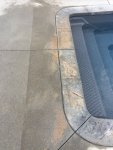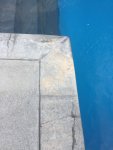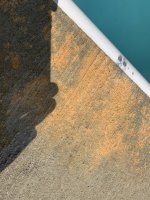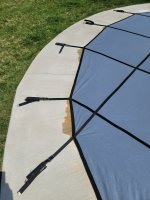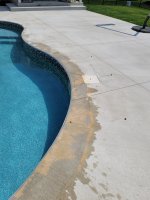I have the same thing. It was just little spots the last couple of years, but this year there are patches, especially where the stairs are. There has to be a solution. It looks awful.
Concrete is Stained, need help
- Thread starter kstruglia
- Start date
You are using an out of date browser. It may not display this or other websites correctly.
You should upgrade or use an alternative browser.
You should upgrade or use an alternative browser.
Perimeter of the pool...was the only affected area under the cover? What I'm getting at here is that many fertilizers contain iron. When left in a wet environment with little chance to evaporate (such as under a pool cover), it could conceivably stain concrete. That's why I was curious as to how many of you that were affected may have fertilized (especially sprayed) soon before or after covering the pool for the winter. Since the source of the stains is still a mystery, it would be interesting to know how many of you had that in common. A bit of a long shot, I know, but once the source is determined, getting rid of the stains becomes much easier.Yes. We thought about that but the staining is just on the perimeter of the pool no where else.
The stain is under the stair cover but the rest of the pool was covered with the traditional snap pool cover, so the stain is on the outside, not under the pool cover.Perimeter of the pool...was the only affected area under the cover? What I'm getting at here is that many fertilizers contain iron. When left in a wet environment with little chance to evaporate (such as under a pool cover), it could conceivably stain concrete. That's why I was curious as to how many of you that were affected may have fertilized (especially sprayed) soon before or after covering the pool for the winter. Since the source of the stains is still a mystery, it would be interesting to know how many of you had that in common. A bit of a long shot, I know, but once the source is determined, getting rid of the stains becomes much easier.
Procka88
New member
Did anyone find a solution to this
We had a cement cleaner come out and he didn’t know what it was and couldn’t clean it. We ended up having to put muriatic acid on it. Not perfect but better. You have to be careful and work quick with it.Did anyone find a solution to this
I sprayed bleach on my stain spots, scrubbed with a hard bristle brush, then hosed off. All of the stains went away. I used Clorox clean up not straight bleach.
Leesadesa2
In The Industry
I can't be positive, but I believe that during the offseason in the northeast, the remaining chemicals in the pool can evaporate under the cover and the evaporated gasses can get trapped under the cover. The vapors can sometimes react with the concrete chemical compounds thus causing discoloration in areas where the cover is in contact with the concrete. Concrete can take several months to cure to 100% which would finally end the on-going chemical reaction of curing. Such discoloration is irreversible but it can blend in overtime due to exposure to the elements. We are researching with masons to see how to resolve this issue. I will update if we find any real answers or resolutions.
I am having the same issue as Lilly123, is muraitic acid our best option, and if so how did you apply it?
This is interesting. I have some weird staining around my pool deck too but it doesn't seem to be from the cover. It almost looks wet? It's definitely getting worse with time too.
Kjp300
Gold Supporter
- Jul 18, 2018
- 192
- Pool Size
- 23000
- Surface
- Vinyl
- Chlorine
- Salt Water Generator
- SWG Type
- Hayward Aqua Rite (T-15)
Sorry Kstruglia, but I think you are going to have to live with it. I have had the same issue, and the first time I noticed it, about 3 years ago, it drove me crazy. Called the pool builder and he had a concrete specialist out. He first tried to power wash it, that did nothing. I then tried bleach, didn't help at all. He then put some kind of cleaning chemical on it, let it sit, power washed it again, and it may have lightened it, but not sure. Now after two more openings, I just kind of accept it. It will lighten as the season wear's on, as the sunlight hits it. I tired to do research on the issue, and no one quite knows what it is (there are a lot of guesses) and how to get rid of it. But it is a common problem.
I just keep my pool water TFP clear, and no one notices. They all comment on the pool water!!
I just keep my pool water TFP clear, and no one notices. They all comment on the pool water!!
Pkstocks
New member
Did you ever find a solution? We are battling the same problem.I have the same thing. It was just little spots the last couple of years, but this year there are patches, especially where the stairs are. There has to be a solution. It looks awful.
I let this go without treatment for 2 or 3 years and it kept getting darker to almost a brownish color. By accident I spilled some liquid pool shock on a spot and within 15-20 minutes, it had lightened almost back to the original deck color. So, I mixed 1/2 gallon of liquid pool shock and 1/2 gallon water. I sprayed it on with garden spray. You can mop it on from a bucket or any good way you can find to distribute the solution over the stain. Caution: if you get this on your clothing, it will bleach quickly. So be careful. You'll want to get the solution on the stain promptly and then go away. Rinse your feet, shoes and socks or whatever got some of the bleach solution on them. On a sunny, low 80 degree day, it took about 20 minutes for almost all of the color to disappear. I then used the pool brush and pool water to lightly scrub the area back to the original deck color. Then I rinsed the area with clean water from the garden hose. In a couple of spots, I had to do this twice. BUT, in an hour or so I had the deck back to original and had cleaned up all tools and put everything away. I think household bleach not diluted would do the same thing, but it may take a little longer. Read the label on your household bleach label. Look for the percentage of sodium hypochlorite. then compare that with the percentage of sodium hypochlorite in your liquid pool shock. I think you'll see the difference in strength. (All household bleach is not the same strength.)
Long story short, it worked great for me. Just use common sense when working with the solution as you would when putting chlorine in your pool.
Long story short, it worked great for me. Just use common sense when working with the solution as you would when putting chlorine in your pool.
The coronavirus has hit your pools!!!!!!!!!!!!! Ha just joking....had to say that! 
Thanks I will try that on the next sunny day and let you know my resultsI let this go without treatment for 2 or 3 years and it kept getting darker to almost a brownish color. By accident I spilled some liquid pool shock on a spot and within 15-20 minutes, it had lightened almost back to the original deck color. So, I mixed 1/2 gallon of liquid pool shock and 1/2 gallon water. I sprayed it on with garden spray. You can mop it on from a bucket or any good way you can find to distribute the solution over the stain. Caution: if you get this on your clothing, it will bleach quickly. So be careful. You'll want to get the solution on the stain promptly and then go away. Rinse your feet, shoes and socks or whatever got some of the bleach solution on them. On a sunny, low 80 degree day, it took about 20 minutes for almost all of the color to disappear. I then used the pool brush and pool water to lightly scrub the area back to the original deck color. Then I rinsed the area with clean water from the garden hose. In a couple of spots, I had to do this twice. BUT, in an hour or so I had the deck back to original and had cleaned up all tools and put everything away. I think household bleach not diluted would do the same thing, but it may take a little longer. Read the label on your household bleach label. Look for the percentage of sodium hypochlorite. then compare that with the percentage of sodium hypochlorite in your liquid pool shock. I think you'll see the difference in strength. (All household bleach is not the same strength.)
Long story short, it worked great for me. Just use common sense when working with the solution as you would when putting chlorine in your pool.
johnpierson
New member
My pool is 1 year old and my cement is 1 year old I have the same issue with staining. My pool is salt water and I have not used any chemicals. What cover does everyone have? My pool guy will not call me back he says it's not his issue and the pool over company is looking into it but saying most likely its not them. It's funny because the bottom of my pool cover is beige and I have beige stains around my pool.
johnpierson
New member
Here are some of my Pictures, what Brand cover does everyone have? I am in PAMy pool is 1 year old and my cement is 1 year old I have the same issue with staining. My pool is salt water and I have not used any chemicals. What cover does everyone have? My pool guy will not call me back he says it's not his issue and the pool over company is looking into it but saying most likely its not them. It's funny because the bottom of my pool cover is beige and I have beige stains around my pool.
Attachments
Try using a paver cleaner or concrete cleaner. You could try vinegar diluted that's what works often for concrete clean up. After you get it clean SEAL your masonry surfaces, you will never have the problem again.
johnpierson
New member
Tried it all. I would love to know what is causing this. We spent a lot of money on the pool and cement. We have a salt water pool.Try using a paver cleaner or concrete cleaner. You could try vinegar diluted that's what works often for concrete clean up. After you get it clean SEAL your masonry surfaces, you will never have the problem again.
Thread Status
Hello , This thread has been inactive for over 60 days. New postings here are unlikely to be seen or responded to by other members. For better visibility, consider Starting A New Thread.


